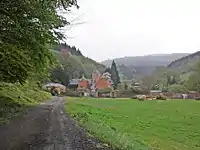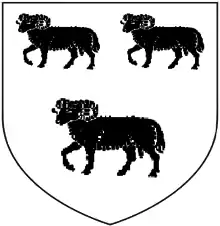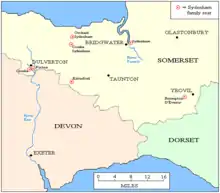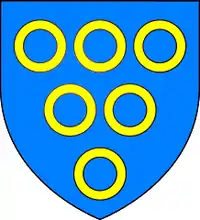

Combe Sydenham is an historic manor in Somerset, England. The 15th-century manor house, called Combe Sydenham House is in the parish of Stogumber, Somerset[1] and is situated just within the boundary of Exmoor National Park. It is a Grade I listed building.[2]
Description of house
The porch was added in 1580 to the south front of the building. The west front was re-fenestrated, and at least two stair turrets were added in about 1600. The south front has been re-fenestrated and buildings to the north and east were demolished.[2]
Description of estate
The house is set in a 500 acres (200 ha) estate which contains a deer park and a variety of walks.[3][4]
Descent
de Moyon/Mohun
Combe Sydenham is mentioned in the Domesday Book of 1086 as one of the many manors held by William de Moyon,[5] 1st feudal baron of Dunster, seated at nearby Dunster Castle, Somerset.
Sydenham


Combe Sydenham Hall was the home of a junior branch of the Sydenham family of Sydenham, Bridgwater, from the 15th century to 1693.[6][7] In 1585 Admiral Sir Francis Drake (c.1540-1596) married Elizabeth Sydenham (born c.1562), the only child and sole heiress of Sir George Sydenham (d.1597),[8] of Combe Sydenham, Sheriff of Somerset,[9] whose monument with effigy survives in the Sydenham Chapel of Stogumber Church. Before the marriage however Drake left on a long voyage and her father arranged for her to be married instead to a son of the Wyndham family of nearby Orchard Wyndham. Tradition states that on the wedding day as the couple approached the Church of St Mary at Stogumber a loud clap of thunder was heard and a large meteorite crashed through the roof. This was seen as a bad omen and the wedding was cancelled. Drake had arrived back in Plymouth on that same day and they were later married at the Church of All Saints in Monksilver. The 14 inches (360 mm) diameteriron meteorite, known as "Drake's cannon ball", has remained at the house ever since and has become smooth from being rolled on the ground.[8] After Drake's death in 1596, Elizabeth Sydenham remarried (as his 2nd wife) to Sir William V Courtenay (1553-1630) of Powderham, Devon.[10]
Sir John Sydenham, 1st Baronet (c. 1620–1643) married a certain Alice, but died before the birth of his posthumous son and heir Sir John Posthumous Sydenham, 2nd Baronet (1643-1696). His widow remarried to Sir Francis Dodington, who resided at Combe Sydenham during the Civil War, as a Royalist, and in 1651 during his tenure Combe Sydenham was confiscated by the Parliamentarians.[11] Parliament purported to sell Combe Sydenham to John Ware, but following the 1660 Restoration of the Monarchy, it was restored to the 2nd Baronet, who in 1693 sold the entire estate to George Musgrave (d. 1721).[12]
Musgrave

Several monuments to the Musgrave family survive in the "Sydenham Chapel" (South Aisle Chapel) of Stogumber Church, which display the arms of Musgrave: Azure, six annulets three, two, one, or.[14] The Musgrave family were previously seated during most of the 17th century at Huish Barton in the parish of Nettlecombe, Somerset, in which house is a plaster overmantel displaying the date 1698 and the monogram of the Musgraves.[15] William Musgrave (1655-1721), of Exeter, a physician and antiquary, was the youngest son of Richard Musgrave of Nettlecombe. He attended the Trevelyan family of Nettlecombe Court, long time lords of the manor of Nettlecombe and wrote several treatises on arthritis and four volumes of Antiquitates Brittanno-Belgicae. The descent of Combe Sydenham in the Musgrave family was as follows:[12]
- George I Musgrave (d.1721), who in 1693 purchased Combe Sydenham from Sir John Posthumous Sydenham, 2nd Baronet (d. 1696). In 1671 he married Juliana Beare (born 1651), a daughter of Thomas Beare (1631-1680) lord of the manor of Huntsham, Devon.[16] His mural monument in Stogumber Church, sculpted on slate,[17] shows the quartered arms of Musgrave impaling the canting arms of Beare: Argent, three bear's heads erased sable muzzled or,[16] here shown couped, not erased, quartering the canting arms of Clavell (de Claville),[18] of Burlescombe, Devon & Loman's Clavell in parish of Uplowman, Devon etc.: Or, three keys gules[19] (Canting arms from Latin Clavis, a "key").
- George II Musgrave (d. 1724)
- George III Musgrave (1717-1742), "of Nettlecombe", Somerset, who died aged 25,[20] whose mural monument exists in Stogumber Church, erected by his daughter and eventual heiress Juliana Musgrave. In 1740 at Sherwell in North Devon, he married Catherine Chichester, eldest daughter of Sir John Chichester, 4th Baronet (1689-1740) of Youlston Park, Sherwell.[20]
- Thomas Musgrave (1741-1766), son and heir, who died unmarried, aged 25 like his father.[21] In 1765 he gave Combe Sydenham to his sister Juliana Musgrave.[12]
- Juliana Musgrave (Lady Langham), who after 1765 married Sir James Langham, 7th Baronet (1736–1795). In 1796, following her husband's death, she sold Combe Sydenham to George Notley of Chillington.[12]
Notley
The descent of Combe Sydenham in the Notley family between 1796 and 1958 was as follows:[12]
- George Notley (d.1831) of Chillington House, Somerset (which he had purchased in about 1766),[22] in 1796 purchased Combe Sydenham from Lady Langham, née Juliana Musgrave, and in about 1800 acquired the adjoining manor of Monksilver. The present public house in Monksilver is called the "Notley Arms"[23] and displays on its sign the armorials of Notley (Or, on a bend cotised azure three bezants) quartering Marwood (Gules, a chevron between three goat's heads erased ermine attired or[24]). In 1800 as part of his marriage settlement he settled part of the estate on his wife Mary Marwood (d.1829), who predeceased her husband when her share reverted to him. Mary was heiress to her brother James Thomas Benedictus Marwood (d.1811), a lunatic, of Widworthy Barton,[25] whose mural monument survives in Widworthy Church, Devon.[23]
- James I Thomas Benedictus Notley (d.1851), 2nd son, his elder brother George Notley (d.1857) as a lunatic having been legally incapable of owning property.[26]
- James II Thomas Benedictus Notley (d.1872), 2nd son, his elder brother George Notley having been "sent abroad to Belgium".[26] He died without progeny.
- Marwood I Notley (1833-1903), younger brother and heir, who had a common law wife Matilda Venn Poole, by whom he had 9 children. He bequeathed his estates jointly to his two youngest sons Montague Notley (born 1878) and Marwood II Notley (1880-c.1958),[26] the latter of whom received as his share Combe Sydenham.
- Marwood II Notley (1880-c.1958), youngest son, who left a daughter and sole heiress Molly Louise Rosewell,[27] who in 1958 sold the estate to Group Captain E. G. Campbell-Voullaire, Royal Air Force.
Campbell-Voullaire
Group Captain E. G. Campbell-Voullaire, Royal Air Force, after a distinguished service during World War II in 1958 purchased Combe Sydenham from the Notley heiress. "It had been terribly run down, and he was putting it all together again".[28] He employed as his farm manager the young John Edwards (b.1926), recently qualified in agriculture at Seale-Hayne College near Exeter, Devon. Edwards went on to farm for himself at Westermill Farm on Exmoor and to serve as a county councillor, an active member of the National Farmers Union, and as a member of the Exmoor National Park Committee since 1972. He stated of his time at Combe Sydenham:[29]
- "And that really was an experience, being farm manager for somebody like Voullaire. He was an extraordinary man, but (we) have remained very good friends ever since because he's such a remarkable man. But incredible difficult. It was very interesting, and very interesting...coping with a rather difficult employer. But he thinks they both respected each other, and he found that interesting. He saw the job written up and applied. Campbell-Voullaire had a succession of farm managers and (Edwards and his wife) were easily the longest inhabitants. He was only just over a year there. As farm manager at Combe Sydenham he worked bloody hard. Running the farm. Peter Batchelor from Exford used to work for them. He was the shepherd. They had a cowman and a tractor driver and one other chap, so he had to organise them. And there was corn, cows, sheep, beef. The estate was about 500 acres he thinks, but Campbell-Voullaire was taking in more and more land and putting the estate back together again, putting a lot of money into it. And woodland. Which they didn't actually have anything to do with. Campbell-Voullaire wasn't really interested. Whereas Theed, who has now bought it, has done the opposite. No, there wasn't a working mill there in those days, though there is now of course because Theed has put that in order. It was just an ordinary Williton area farm. Good land, steep land but a good bit of ground. And they did quite a bit of reclamation, on the steep ground. They had Sid Sherring doing a lot of the steep work. It was a very good experience. Very interesting.
Theed
- William A.C. Theed is the present owner in 2015, as he was in 1979.[12] His estate at Combe Sydenham includes 130 hectares of commercial woodland, which are open to public access for various leisure activities such as off-road vehicle and mountain biking. In 2012 he won the Royal Forestry Society Duke of Cornwall Multipurpose Woodlands Award.[30]
2020 sale
In 2020, substantial forest land near Combe Sydenham was sold to SMH Woodland Ltd, a UK company believed to be controlled by Sir Michael Hintze an Australian property investor with the sporting rights were sold separately to a London-based investment group.[31] <inadequate citation>
Further reading
- Jefferies, Richard, Red Deer, 1884, chapter A Manor House in Deer Land. An atmospheric account of Combe Sydenham at the end of the 19th century.
- Pearson, Eustace H., "Do Not Lie! The Notleys of Somerset & Dorset", 1991
See also
References
- ↑ latitude=51.1225, longitude=-3.3215
- 1 2 Historic England. "Combe Sydenham (1057497)". National Heritage List for England. Retrieved 6 February 2009.
- ↑ "Combe Sydenham Country Park". Enjoy England. Retrieved 12 April 2009.
- ↑ "Combe Sydenham Hall". Historic Houses Association. Archived from the original on 2 February 2010. Retrieved 12 April 2009.
- ↑ Domesday Book: A Complete Translation. London: Penguin, 2003. ISBN 0-14-143994-7 p.262-6
- ↑ Collinson, Rev. John, History and Antiquities of the County of Somerset, Vol.3, Bath, 1791, p.547
- ↑ "Combe Sydenham". Mysterious Britain and Ireland. Retrieved 12 April 2009.
- 1 2 Warren, Derrick (2005). Curious Somerset. Stroud: Sutton Publishing. pp. 90–91. ISBN 978-0-7509-4057-3.
- ↑ "The Occupants of the ancient office of High Sheriff of Somerset". Tudor Court. Retrieved 30 March 2011.
- ↑ "COURTENAY, Sir William I (1553-1630), of Powderham, Devon". History Of Parliament. The History of Parliament Trust. Retrieved 10 November 2015.
- ↑ A P Baggs, R J E Bush and M C Siraut, 'Parishes: Stogumber', in Victoria Coubty History, Somerset: Volume 5, ed. R W Dunning (London, 1985), pp. 177-190 http://www.british-history.ac.uk/vch/som/vol5/pp177-190
- 1 2 3 4 5 6 Baggs, Bush & Siraut
- ↑ Jefferson, Samuel, History and Antiquities of Leath Ward: in the County of Cumberland, Carlisle, 1840, p.411
- ↑ Later branches of the Musgrave family adopted differences of the original Musgrave arms, for example Argent, on a pile per pale azure and gules six annulets or (Burke's Genealogical and Heraldic History of the Landed Gentry, 15th Edition, ed. Pirie-Gordon, H., London, 1937, p.1657). The Musgrave arms depicted on monuments in Stogumber Church are much effaced, but the 6 annulets are clearly discernible
- ↑ baggs, Bush & Siraut, "Parishes: Nettlecombe"
- 1 2 Vivian, 1895, p.60, pedigree of Beare
- ↑ Image, see
- ↑ Image see File:ClavellArms.PNG
- ↑ per Pole, Sir William (d.1635), Collections Towards a Description of the County of Devon, Sir John-William de la Pole (ed.), London, 1791, pp.447 & 478
- 1 2 Per mural monument in Stogumber Church
- ↑ Per his father's mural monument in Stogumber Church
- ↑ "Marwood Notley".
- 1 2 marwoodnotley.blogspot, based on Pearson
- ↑ Vivian, Lt.Col. J.L., (Ed.) The Visitations of the County of Devon: Comprising the Heralds' Visitations of 1531, 1564 & 1620, Exeter, 1895, p.560, pedigree & arms of Marwood of Westcot
- ↑ Pevsner, Nikolaus & Cherry, Bridget, The Buildings of England: Devon, London, 2004, p.910
- 1 2 3 marwoodnotley.blogspot
- ↑ Rosewell, C. J. (2017). Rosewell of the Blackdown Hills - 1436-2004. Somerset Heritage Centre, A\DUK - 2017/121, pp. 62.
- ↑ Exmoor Oral History Archive, John Edwards, 2/2
- ↑ Exmoor Oral History Archive, John Edwards, 2/2, recorded in 2001
- ↑ Somerset County Gazette, 11 August 2012
- ↑ HM Land Registry 2020 Property Sales, 12 April 2021